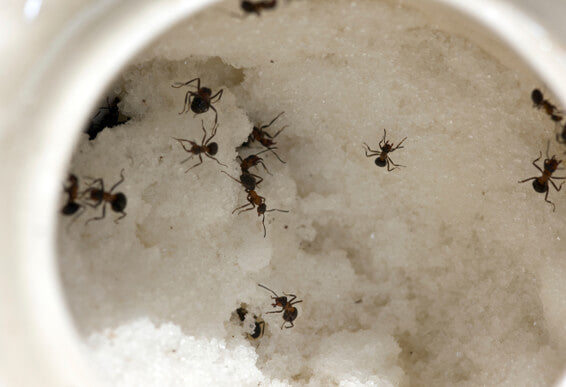
Ants are one of the most common insects that invade the home. Depending on the climate, they can be anything from an occasional nuisance to a persistent pest. Being such a regular home visitor, there are many products devised to take care of them; so why use an organic ant control? Natural products like diatomaceous earth will be a natural and chemical-free alternative to use around your kids and pets. DE will continue to work long after any chemical products' effect has dissipated, naturally repelling ants as long as the powder remains.
For instructions on how to use DE in your home to combat any ants, follow the steps below.
You will need:
- Crawling Insect Control Diatomaceous Earth
- An Applicator like this one for wet applications or this one for dry applications
Dry:
Step 1:
Find areas around your house where you have seen ants crawling. Mark places where you think and may be able to enter your house. If ants have been moving across a large flat area, or have been moving up walls, you may want to use a wet application. If the ants have been moving along edges and cracks, baseboards and floorboards, or are working their way along window sills, you may want a dry application.
Step 2:
Apply diatomaceous earth. You can use a duster to target along edges, behind baseboards, and any other hard to reach places. Alternatively, you can use a flour sifter to lightly dust larger problem areas. Also, take time to target parts of your windows and doors that you find susceptible.
Step 3:
Watch the areas that have been treated and make note of alternate routes taken by ants to see if any follow-up applications are needed. After a month, clean off the areas where you have applied DE and reapply. Pay particular attention to the areas where ants can get into your house to prevent future ant trails
Try Crawling Insect Control Diatomaceous Earth
Wet:
Step 1:
Find areas around your house where you have seen ants crawling. Mark places where you think and may be able to enter your house. If ants have been moving across a large flat area, or have been moving up walls, you may want to use a wet application. If the ants have been moving along edges and cracks, baseboards and floorboards, or are working their way along window sills, you may want a dry application.
Step 2:
Follow the instructions for the application listed here. Use the spray bottle to target larger areas such as walls, where you have seen ants traveling. This type of application is not good for small nooks and crannies. DE will not work while it is wet but only after the water evaporates will it take effect. Take that into consideration as you make your applications.
Step 3:
Watch the areas where you have sprayed, take note of alternate routes taken by ants, and treat accordingly. After a month, clean off the areas where you have applied DE and reapply. Pay particular attention to the areas where ants can get into your house to prevent future ant trails
If you have questions about the other ways to combat ant hills and ant trails outside, click here.


